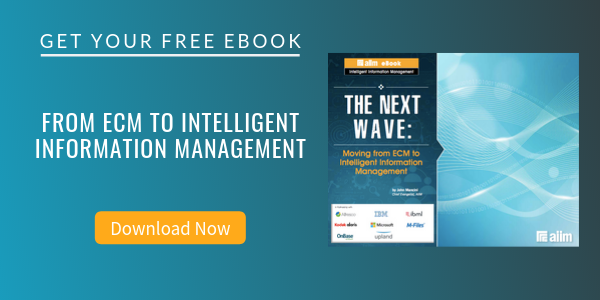
ECM in the Era of Digital Disruption - When Riding a Dead Horse, Dismount
Enterprise Content Management (ECM) | Intelligent Information Management (IIM)
The challenge of managing the intersection of people, processes, and information is not a new one. However, the technologies and the timeframes that we use to manage this intersection DO change, and we are currently in the middle of a phase of high disruption and uncertainty.
Specifically, I am talking about how we manage the intersection of people, processes, and information to:
- Improve business processes to produce optimal business results; and
- Document or record those results and the information associated with them.
Organizations have dealt with the challenge associated with the intersection of people, processes, and information through a series of technology waves. In each wave or era, it took some time for norms and best practices and standards to emerge. Ultimately these norms did -- generating a period of widespread adoption of that particular technology -- only to be disrupted by the next wave of technology innovation.
A couple of things are constants during periods of transition:
- In between eras, the technologies that ultimately become dominant in the next era struggle for an identity and a label. Ultimately an “industry” of key players emerge, and once this happens, the chaos that was characteristic of the time between eras is forgotten.
- In the early stages of each era, early adopters struggle with an absence of clear rules and best practices on how to best proceed. Again, these ultimately emerge, but not without a great deal of confusion during the interim.
I believe there have been five main eras in managing the people, process, and information intersection.
- The Paper Era: For hundreds of years, the technology that fueled the intersection of people, processes, and information was paper.
- The Micrographics Era: During the 1950s, paper began to be replaced -- especially for the task of documenting and recording -- by microfilm, and the Micrographics Industry was born. But, paper still remained the primary technology tied to the unstructured information in a business process.
- The ERP Era: In the 1960s, 1970s, and into the 80s, the first great wave of enterprise IT spending replaced ledgers with data, automated a significant portion of core back-end business processes, and gave birth to the ERP Industry. Amidst this automation, paper still retained its dominant role -- it remained the primary means to convey information and was the primary way that business was documented on a daily basis.
- The Document Management and Workflow Era: In the 1980s and 1990s, we replaced some of this paper -- mostly the high-volume kind -- in selected, mission-critical processes (like new drug applications in pharmaceuticals or claims processing in insurance). We used closed local area networks to move these new electronic documents around among a limited number of specialized workers within the four walls of the enterprise. Document Management/Workflow emerged as the label we used to describe this era of people, processes, and information.
- The ECM Era: The emergence of the internet and the maturation of core document management and imaging technologies ushered in the Enterprise Content Management Era in the early 2000s. Never a perfect industry label -- and probably more accurately a verb (something you do) than a noun (something you buy) -- “ECM” nonetheless served as a useful umbrella term for a decade. ECM described a cluster of capabilities and technologies that organizations used to capture, store, manage, deliver, and preserve the “content” (mostly images and documents) associated with processes that were 1) document-intensive; and 2) mission-critical.
The Transition to a Sixth Era: Beyond ECM
We are now beginning the transition to a sixth era -- beyond ECM -- in managing people, processes, and technology. The combined impact of consumerization, cloud and mobile, and the Internet of Things are rapidly signaling the end of the ECM Era as we know it. Organizations are struggling with best practices and norms as they make the transition to this sixth era dominated by Mobile, Analytics, Cloud, and Collaborative (MACC) technologies, and the solution providers that are part of this change are struggling with their identity as an industry. We at the cusp of a sixth era, still to be defined.
There are several key MACC-stack driven trends on the 2020 horizon – and remember, 2020 is just 5 years away:
- New approaches to privacy and security.
- Ubiquitous broadband connectivity.
- Bottom-up rather than top-down innovation.
- Lots more virtual and distributed work.
- A shortage of IT “connective” and analytic skills.
- An OPEX vs. CAPEX procurement model.
- Increased regulation of the cloud by national governments.
As we prepare for these massive changes, we need to do so conscious that best practices in this emerging era do not yet exist. The community forged at AIIM15 represents the community of leaders who will help forge them.
Just having come out of The AIIM Conference 2015, my challenge for this community is this: Between now and AIIM16, we need to break down the issues we face into very practical and direct terms that can be understood by the business.
The problem is not that ECM is no longer relevant. It IS a good description of the set of capabilities that evolved from document management and workflow, and a good label for the technologies and capabilities needed to automate relatively static, document-intensive, mission-critical processes. “Every organization, every executive, every individual, every object is on a digital journey and content is at the heart of that journey,” notes futurist Thornton May. “Content is ubiquitous and critical, but ECM is rapidly becoming invisible.”
However, “ECM” as has problems on three fronts as we think about the "6th era": 1) we have tended to use it as a noun rather than a verb (something you buy and plug-in, rather than a strategy that you pursue); 2) it no longer works as an umbrella for the content and information-centric technologies that are at the core of the Mobile, Analytics, Cloud, and Collaborative era; 3) it is almost exclusively associated with cost reduction and people reduction.
Automation and people reduction are how “ECM” has been sold over the past decade -- and particularly in bad economic times. We’re coming to the end of that cycle; we’ve pretty much automated what we can automate. A new “umbrella” term is needed. ECM needs to become PART of the puzzle, rather than the puzzle itself. There will be many pieces to this puzzle in 2020 -- Content Management, Information Governance, Smart Process Applications, Collaboration, and Social Technologies, Taxonomy and Metadata, Scanning and Capture, Content Analytics, Customer Engagement, and Search -- and the lines between “unstructured” and “structured” information will further blur. Organizations must combine analytics, collaboration, governance, and processes to manage and leverage information assets more intelligently.
As an industry and as information professionals, we usually tend to explain the business problems we solve in “elevator pitches” that would take a 4,000-story elevator to tell and in insider terms that the business just doesn’t get. And pitches that are so rooted in where we have been that we forget to tell people where we are going. So as John Leggate, former CIO at BP, said during a recent AIIM ELC meeting, "When riding a dead horse, dismount!"
So over the next year, let’s get very practical. Let’s tell our story and build best practices in straight-forward terms focused on the twin problems confronting all knowledge workers who operate in the transforming digital workplace:
Where do I put my “stuff” so that it is secure, shareable, and searchable so that my ORGANIZATION can accomplish its goals?
and
How can I do so in a way that works the way I work and is useful to ME in getting my job done?
Let’s get to work. What do you think?
About John Mancini
John Mancini is the President of Content Results, LLC and the Past President of AIIM. He is a well-known author, speaker, and advisor on information management, digital transformation and intelligent automation. John is a frequent keynote speaker and author of more than 30 eBooks on a variety of topics. He can be found on Twitter, LinkedIn and Facebook as jmancini77. Recent keynote topics include: The Stairway to Digital Transformation Navigating Disruptive Waters — 4 Things You Need to Know to Build Your Digital Transformation Strategy Getting Ahead of the Digital Transformation Curve Viewing Information Management Through a New Lens Digital Disruption: 6 Strategies to Avoid Being “Blockbustered” Specialties: Keynote speaker and writer on AI, RPA, intelligent Information Management, Intelligent Automation and Digital Transformation. Consensus-building with Boards to create strategic focus, action, and accountability. Extensive public speaking and public relations work Conversant and experienced in major technology issues and trends. Expert on inbound and content marketing, particularly in an association environment and on the Hubspot platform. John is a Phi Beta Kappa graduate of the College of William and Mary, and holds an M.A. in Public Policy from the Woodrow Wilson School at Princeton University.



